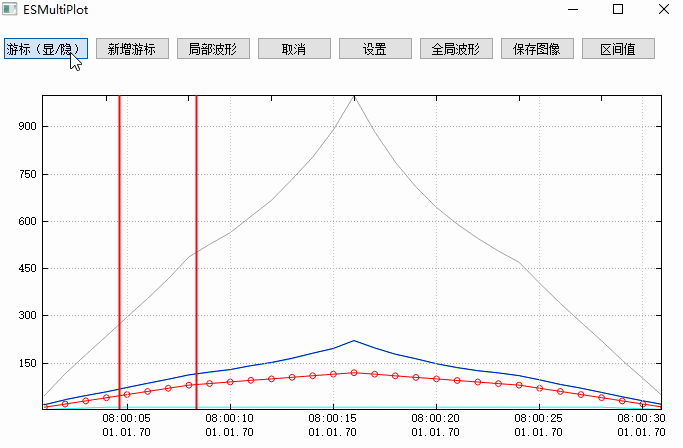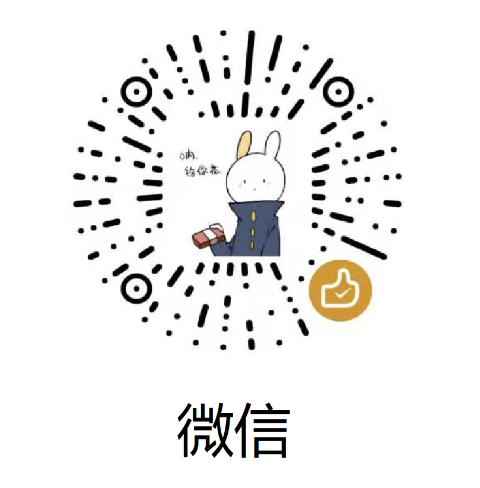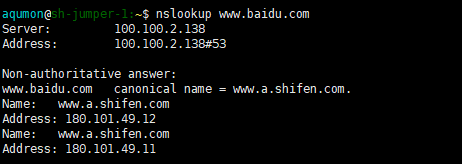QCustomplot使用分享(九) 绘制图表-多功能游标
- 2019 年 10 月 26 日
- 笔记
目录
原文链接:QCustomplot使用分享(九) 绘制图表-多功能游标
一、概述
上一篇文章QCustomplot使用分享(八) 层(完结)讲述了第一篇QCustomPlot控件的使用,主要是展示了多维度折线图,并且有一个简单的游标展示效果。本篇文章是在上一篇文章的基础上进行的功能加强,主要是针对游标进行优化,提供更加丰富的游标功能。
二、效果图
如下图所示,是我做的一个测试效果图,途中包括一个简单的折线图和一系列游标,折线图的显示模式有十几种效果,具体可以看QCustomplot使用分享(一) 能做什么事这篇文章里的截图,这里我就不在贴出。

这个效果图主要展示了游标的使用,其他相关功能可以参考之前写的文章,本篇文章最后也会通过相关文章小节提供,感兴趣的同学可以去文末查找。
演示demo中的数据是读取于cvs文件,如果大家自己想从其他渠道获取数据也可以,这个绘图控件已经添加了足够的接口可供调用。
绘图控件提供的游标功能如下,比如:
- 多种类游标,单游标,双游标
- 游标显示、隐藏,支持移动
- 双游标锁定移动,非锁定移动
- 获取游标区间值
- 设置游标颜色
- 获取游标区间数据
下面的文章中我会分析下主要的接口和核心功能实现
图中的展示效果测试代码如下,代码中的关键节点就2个
- 构造ESCvsDBOperater类,并加载cvs文件
- 通过Set接口设置数据,并设置折线图类型
ESCsvDBOperater * csvDBOperater = new ESCsvDBOperater(nullptr); csvDBOperater->loadCSVFile(qApp->applicationDirPath() + "\temp\test31.csv"); QStringList names = csvDBOperater->getCSVNames(); auto callback = [this, names](const QString & name, const QVector<double> & data){ int index = names.indexOf(name); if (index != -1) { if (index == 0) { ui->widget->SetGraphKey(data); } else { int l = name.indexOf("("); int r = name.indexOf(")"); if (l != -1 && r != -1) { ui->widget->SetGraphValue(index - 1, name.left(l), /*name.mid(l + 1, r - l - 1)*/"", data); ui->widget->SetGraphScatterStyle(index - 1, 4); } else { ui->widget->SetGraphValue(index - 1, name, "", data); } } }当然QCP不仅仅能显示折线图,他还可以显示各种各样的效果图,感兴趣的到QCustomplot使用分享(一) 能做什么事文章中观看
三、源码讲解
1、源码结构
如图所示,是工程的头文件截图,图中的文件数量比较多,但是对外我们使用的可能只是一个ESMPMultiPlot类,这个类中提供了很多接口,足够我们使用,当然了如果有特殊需求的话,可以进行提供定制

2、头文件
如下是头文件中的接口,我只是把相关的Public接口列出来了,而这些接口也正好是我们平时使用比较多的接口,看接口名称应该都知道接口是干什么的,因此不再细说
void ClearCache();//清空上一个csv绘图数据 void SetGraphCount(int);//设置折线图个数 void SetGraphKey(const QVector<double> &);//设置x轴数据 void SetGraphKeyRange(double, double);//设置x轴范围,即时间范围 void SetGraphScatterStyle(int, int);//设置折线图样式 void SetGraphValue(int, const QString &, const QString & , const QVector<double> &);//设置折线图数据 void AppendGraphValue(int, double, double);//追加折线图数据 void AppendGraphValue(int, const QVector<double> &, const QVector<double> &);//追加折线图数据 QVector<double> GetGraphValues(int, int);//获取折线图 游标区间值 参数1:折线下标 参数2:游标order QString GetGraphName(int) const; void SetGraphColor(int, const QColor &);//设置折线图颜色 QColor GetGraphColor(int);//获取折线图颜色 void SetSingleCursor(bool single);//启动单游标 bool IsSingleCursor(int index) const;//测试游标是否是单游标 void ShowCursor(bool visible = true);//设置游标是否显示 void AppendCursor(const QColor & color);//新增游标 void LockedCursor(int, bool);//锁定指定游标 参数2表示是否锁定 int CursorCount() const; bool CursorVisible() const;//游标是否显示 void SetCursorColor(int index, const QColor &);//设置游标颜色 第二个参数指示哪个游标 double GetCursorKey(bool);//获取游标对象x轴值 true表示左游标 false表示右游标 double GetCursorKey(int index, bool);//获取游标对象x轴值 true表示左游标 false表示右游标 void ResizeKeyRange(bool, int index = 0);//设置x轴缩放 true时按游标缩放 false时恢复默认状态 void ResizeValueRange();//y轴自适应 void ConfigureGraph();//设置 void ConfigureGraphAmplitude(int);//双击右侧单位时触发 void SavePng(const QString & = "");//保存图片 1、分析时 自动执行并传入路径 2、点击保存图形按钮时 传空路径3、添加游标
如下是模拟添加游标的代码,通过一个变量i来模拟不同情况,添加不同类型的游标,当前支持添加可移动单游标、可移动双游标、可锁定拖动双游标
- 单游标:单挑线,可以用鼠标进行拖拽
- 可移动双游标:两条线,分别移动,左边游标永远不会大于右边游标
- 可锁定拖动双游标:两条线,锁定移动,也就是说不管移动那条线,另一条线会同步移动,并一直在窗口内
void ESMultiPlot::on_pushButton_add_cursor_clicked() { graphColor.append(Qt::red); graphColor.append(Qt::green); graphColor.append(Qt::blue); graphColor.append(Qt::gray); graphColor.append(Qt::cyan); graphColor.append(Qt::yellow); graphColor.append(Qt::magenta); static int i = 1; if (i % 3 == 0) { ui->widget->SetSingleCursor(true); ui->widget->AppendCursor(graphColor[rand() % 6 + 1]); } else if (i % 3 == 1) { ui->widget->SetSingleCursor(false); ui->widget->AppendCursor(graphColor[rand() % 6 + 1]); ui->widget->LockedCursor(i, false); } else { ui->widget->SetSingleCursor(false); ui->widget->AppendCursor(graphColor[rand() % 6 + 1]); ui->widget->LockedCursor(i, true); } ++i; }如上代码所示,SetSingleCursor设置为true时,表示接下来要添加的游标是单游标;LockedCursor可以锁定指定双游标,对单游标不生效。
4、监测移动
多游标模式下移动游标比一组游标复杂一些,我们需要循环监测所有的游标,并获取一个可移动游标。
这里获取移动游标的逻辑为距离鼠标按下的位置在5个像素以内的游标,并且优先响应先构造的游标,如果左右游标同时满足的话优先响应右游标
void ESMPMultiPlot::mousePressEvent(QMouseEvent * event) { if (m_bCursor) { m_bDrag = true; for (int i = 0; i < m_pCursors.size(); ++i) { QCPItemStraightLine * leftCursor = m_pCursors.at(i).leftCursor; bool ispressed = false; double distance = leftCursor->selectTest(event->pos(), false); if (distance <= 5 && axisRect()->rect().contains(event->pos())) { m_bDragType = 1; m_bLeftCursor = true; ispressed = true; m_bLock = m_pCursors.at(i).lock; m_bSingleCursor = m_pCursors.at(i).single; m_bOrder = i; } QCPItemStraightLine * rightCursor = m_pCursors.at(i).rightCursor; distance = rightCursor->selectTest(event->pos(), false); if (distance <= 5 && axisRect()->rect().contains(event->pos())) { m_bDragType = 1; m_bLeftCursor = false; ispressed = true; m_bLock = m_pCursors.at(i).lock; m_bSingleCursor = m_pCursors.at(i).single; m_bOrder = i; } if (ispressed) { break; } } } for (int i = 0; i < m_vecNames.size(); ++i) { double distance = m_vecNames[i]->selectTest(event->pos(), false); //QPointF posF = m_vecNames[i]->position->pixelPosition; if (distance <= 13 && m_vecNames[i]->visible()) { m_bDragType = 2; m_iDragIndex = i; break; } } __super::mousePressEvent(event); }5、移动游标
QCustomplot使用分享(八) 层(完结)文章讲述的是一组游标移动,移动游标时需要考虑的点比较少,分别是:
- 游标时不能移出界面
- 左游标必须小于右游标
本篇文章的多组游标移动相对来说考虑的点就需要更多一些,分别是:
游标默认值游标组(一个游标、或者两个游标);左右游标是针对两个游标而言
基础规则
- 游标不能移出界面
单游标
- 左侧为双游标时,与左侧右游标比,反之与左游标比
- 右侧直接与左游标比
双游标非锁定-移动左侧游标
- 左侧为双游标时,与左侧右游标比,反之与左游标比
- 右侧直接与右游标比
双游标非锁定-移动右侧游标
- 右侧直接与右侧游标左游标比
- 左侧直接与左游标比
双游标锁定
- 右移时,直接用右游标与右侧游标的左游标比
- 左移时,直接用左游标与左侧游标的右游标比
如下代码所示,是移动游标的核心代码,主要的移动情况,上边已经说了,下边移动逻辑就不在细说,感兴趣的同学可以自己查看,需要提供定制的可以加我QQ。
void ESMPMultiPlot::mouseMoveEvent(QMouseEvent * event) { if (m_bDragType == 1 && m_bDrag) { double pixelx = event->pos().x(); QCPRange keyRange = axisRect()->axis(QCPAxis::atBottom)->range(); double min = axisRect()->axis(QCPAxis::atBottom)->coordToPixel(keyRange.lower); double max = axisRect()->axis(QCPAxis::atBottom)->coordToPixel(keyRange.upper); if (min + 1 > pixelx) { pixelx = min + 1; } else if (max - 1 < pixelx) { pixelx = max - 1; } //按住左游标移动 double move_distance = 0; double rcursor = m_pCursors[m_bOrder].rightCursor->point1->key(); double rcursorx = axisRect()->axis(QCPAxis::atBottom)->coordToPixel(rcursor); double lcursor = m_pCursors[m_bOrder].leftCursor->point1->key(); double lcursorx = axisRect()->axis(QCPAxis::atBottom)->coordToPixel(lcursor); if (m_bLeftCursor) { //修正左边 if (m_bOrder != 0) { double rcursor; if (m_pCursors[m_bOrder - 1].rightCursor->visible()) { rcursor = m_pCursors[m_bOrder - 1].rightCursor->point1->key(); } else//左侧是单游标 { rcursor = m_pCursors[m_bOrder - 1].leftCursor->point1->key(); } double rcursorx = axisRect()->axis(QCPAxis::atBottom)->coordToPixel(rcursor); if (pixelx <= rcursorx + 4) { pixelx = rcursorx + 4; } move_distance = rcursorx - pixelx;//可向左移动距离(向左为负) } else { if (pixelx <= min + 2) { pixelx = min + 2; } move_distance = min - pixelx;//可向左移动距离(向左为负) } //修正右边 if (m_bLock)//锁定移动 { move_distance = pixelx - lcursorx;//往右准备移动的距离 if (m_bOrder == m_pCursors.size() - 1) { if (rcursorx + move_distance > max - 2) { move_distance = max - 2 - rcursorx;//往右真正可移动距离 } } else { double nlcursor = m_pCursors[m_bOrder + 1].leftCursor->point1->key(); double nlcursorx = axisRect()->axis(QCPAxis::atBottom)->coordToPixel(nlcursor); if (rcursorx + move_distance > nlcursorx - 4) { move_distance = nlcursorx - 4 - rcursorx;//往右真正可移动距离 } } } else { if (m_bSingleCursor) { move_distance = pixelx - lcursorx;//往右准备移动的距离 if (m_bOrder == m_pCursors.size() - 1) { if (lcursorx + move_distance > max - 2) { move_distance = max - 2 - lcursorx;//往右真正可移动距离 } } else { double nlcursor = m_pCursors[m_bOrder + 1].leftCursor->point1->key(); double nlcursorx = axisRect()->axis(QCPAxis::atBottom)->coordToPixel(nlcursor); if (lcursorx + move_distance > nlcursorx - 4) { move_distance = nlcursorx - 4 - lcursorx;//往右真正可移动距离 } } } else { if (pixelx >= rcursorx - 4) { pixelx = rcursorx - 4; } move_distance = pixelx - lcursorx;//可向右移动距离(向右为正) } } } else//按住右游标移动 { //修正右边 if (m_bOrder != m_pCursors.size() - 1) { double lcursor = m_pCursors[m_bOrder + 1].leftCursor->point1->key(); double lcursorx = axisRect()->axis(QCPAxis::atBottom)->coordToPixel(lcursor); if (pixelx >= lcursorx - 4) { pixelx = lcursorx - 4; } move_distance = pixelx - lcursorx;//可向右移动距离 } else { if (pixelx >= max - 2) { pixelx = max - 2; } move_distance = pixelx - lcursorx;//可向右移动距离 } //修正左边 if (m_bLock)//锁定移动 { move_distance = pixelx - rcursorx;//往左准备移动的距离 if (m_bOrder == 0) { if (lcursorx + move_distance <= min + 2) { move_distance = min + 2 - lcursorx;//往左真正可移动距离 } } else { double nlcursor = m_pCursors[m_bOrder - 1].rightCursor->point1->key(); double nlcursorx = axisRect()->axis(QCPAxis::atBottom)->coordToPixel(nlcursor); if (lcursorx + move_distance <= nlcursorx + 4) { move_distance = nlcursorx + 4 - lcursorx;//往右真正可移动距离 } } } else { if (pixelx <= lcursorx + 4) { pixelx = lcursorx + 4; } move_distance = pixelx - rcursorx;//可向左移动距离(向左为负) } } double key; if (m_bLeftCursor) { key = axisRect()->axis(QCPAxis::atBottom)->pixelToCoord(lcursorx + move_distance); m_pCursors[m_bOrder].leftCursor->point1->setCoords(key, m_pCursors[m_bOrder].leftCursor->point1->value()); m_pCursors[m_bOrder].leftCursor->point2->setCoords(key, m_pCursors[m_bOrder].leftCursor->point2->value()); } else { key = axisRect()->axis(QCPAxis::atBottom)->pixelToCoord(rcursorx + move_distance); m_pCursors[m_bOrder].rightCursor->point1->setCoords(key, m_pCursors[m_bOrder].rightCursor->point1->value()); m_pCursors[m_bOrder].rightCursor->point2->setCoords(key, m_pCursors[m_bOrder].rightCursor->point2->value()); } if (m_bLock) { if (m_bLeftCursor) { key = axisRect()->axis(QCPAxis::atBottom)->pixelToCoord(rcursorx + move_distance); m_pCursors[m_bOrder].rightCursor->point1->setCoords(key, m_pCursors[m_bOrder].rightCursor->point1->value()); m_pCursors[m_bOrder].rightCursor->point2->setCoords(key, m_pCursors[m_bOrder].rightCursor->point2->value()); } else { key = axisRect()->axis(QCPAxis::atBottom)->pixelToCoord(lcursorx + move_distance); m_pCursors[m_bOrder].leftCursor->point1->setCoords(key, m_pCursors[m_bOrder].leftCursor->point1->value()); m_pCursors[m_bOrder].leftCursor->point2->setCoords(key, m_pCursors[m_bOrder].leftCursor->point2->value()); } } event->accept(); replot(); emit CursorChanged(m_bLeftCursor); return; } else if (m_bDragType == 2) { double pixely = event->pos().y(); QCPRange keyRange = axisRect()->axis(QCPAxis::atLeft)->range(); double max = axisRect()->axis(QCPAxis::atLeft)->coordToPixel(keyRange.lower); double min = axisRect()->axis(QCPAxis::atLeft)->coordToPixel(keyRange.upper); if (min > pixely) { pixely = min; } else if (max < pixely) { pixely = max; } m_vecNames[m_iDragIndex]->position->setType(QCPItemPosition::ptPlotCoords); double coordy1 = axisRect()->axis(QCPAxis::atLeft)->pixelToCoord(pixely); double coordx = m_vecNames[m_iDragIndex]->position->coords().rx(); double coordy = m_vecNames[m_iDragIndex]->position->coords().ry(); m_vecNames[m_iDragIndex]->position->setCoords(coordx, coordy1); m_vecUnits[m_iDragIndex]->position->setType(QCPItemPosition::ptPlotCoords); m_vecUnits[m_iDragIndex]->position->setCoords(m_vecUnits[m_iDragIndex]->position->coords().rx(), coordy1); (*m_graphConfigure)[m_iDragIndex].position += (coordy1 - coordy); RefrushGraph(m_iDragIndex); event->accept(); replot(); return; } __super::mouseMoveEvent(event); }在ESMPPlot类中,m_mapLeftCursor和m_mapRightCursor分别是左右游标,为什么这里取了一个map呢?答案是:当时设计的时候是支持多个垂直摆放的游标可以进行游标同步,如果炒股的同学可能就会知道,k线和指标之间可能会有一个数值方便的线,不管在哪个绘图区进行移动,另一个图表里的线也会跟着移动
不了解这个的同学也不要紧,我们这个控件默认的就是一个表,因此这个map里也就只存了一个指,因此可以不关心这个问题
在ESMPMultiPlot类中,我们模拟了ESMPPlot的功能,这个时候呢?我们的坐标轴矩形只有一个了,x轴都是一样的,表示时间,对于不同曲线的y轴我们进行了平移,以达到不同的显示位置
这里边有一个很重的技巧,那就是我们对y轴数据进行了一次单位换算,让他显示的时候可以更好显示在我们制定的区域内,可能像下面这样
/* y1p=(y1-Yzero1)/Ygrid1+Xaxis1;%核心转换公式,将原始坐标值y1转换为新坐标值y1p y1;%原始数值 Yzero1;%零点幅值,决定曲线1零点位置的变量 Ygrid1;%单格幅值,决定曲线1每个单元格大小的量 Xaxis1;%显示位置,决定曲线1在画图板中显示位置的变量 */当然了,我们转换后的坐标只是为了显示方便而已,如果我们根据UI获取原始值,我们还需要使用一个逆向公式进行转换回去。
6、其他函数
还有一些其他的方法,比如保存图表、获取图表坐标、设置图表颜色等这里就不细讲了,文章篇幅所限,不能一一的都贴出来,有需要的伙伴可以联系我,提供功能定制。
四、测试方式
1、测试工程
控件我们将的差不多了,这里把测试的代码放出来,大家参考下,首先测试工程截图如下所示,我们的测试代码,大多数都是写在了main函数中。

2、测试文件
这里简单说名下,我们的这个文件用途,第一列Time是代表了x轴的时间,而第二列开始的数据都是我们的折线图,一列数据代表一条折线图,并且列的名称就是我们折线图左侧的名称;列名称括号里的单位就是折线图右侧的单位。

3、测试代码
限于篇幅,这里我还是把无关的代码删减了很多,需要完整的源码的可以联系我。
void ESMPMultiPlot::LoadData() { ESCsvDBOperater * csvDBOperater = new ESCsvDBOperater(nullptr); csvDBOperater->loadCSVFile(qApp->applicationDirPath() + "\temp\test31.csv"); QStringList names = csvDBOperater->getCSVNames(); auto callback = [this, names](const QString & name, const QVector<double> & data){ 添加图表数据 }; ui->widget->SetGraphCount(names.size() - 1); for (int i = 0; i < names.size(); ++i) { csvDBOperater->receiveData(names[i], callback); } double start = csvDBOperater->getStartTime(); double end = csvDBOperater->getEndTime(); csvDBOperater->receiveData(names[2], 10.201, 10.412, callback); QVector<double> tiems = csvDBOperater->getRangeTimeDatas(10.201, 10.412); ui->widget->SetGraphKeyRange(start, end); }五、相关文章
- QCustomplot使用分享(一) 能做什么事
- QCustomplot使用分享(二) 源码解读
- QCustomplot使用分享(三) 图
- QCustomplot使用分享(四) QCPAbstractItem
- QCustomplot使用分享(五) 布局
- QCustomplot使用分享(六) 坐标轴和网格线
- QCustomplot使用分享(七) 层(完结)
- QCustomplot使用分享(八) 层(完结)
六、总结
QCustomPlot是一个非常强大的绘图类,并且效率很高,对效率要求较高的程序都可以使用。
本篇文章是继前7篇讲解QCP后的第二篇使用案例,后续还会陆续提供更多复杂的功能。
这个控件已经被我封装成一个dll,如果有需要的小伙伴可以加我咨询
七、关于美化
因为我这里的程序都是测试程序,因此都是使用的原生效果,如果有需要美化的同学,或者客户,我也可以提供定制美化功能,欢迎咨询。
 |
 |
很重要–转载声明
-
本站文章无特别说明,皆为原创,版权所有,转载时请用链接的方式,给出原文出处。同时写上原作者:朝十晚八 or Twowords
-
如要转载,请原文转载,如在转载时修改本文,请事先告知,谢绝在转载时通过修改本文达到有利于转载者的目的。


